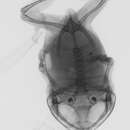Description
provided by AmphibiaWeb articles
Diagnosis: The broad head (HW/SVL= 0.5), widely spaced nostrils (internarial distance more than distance from eye to naris), and small eyes distinguish it from all other New Guinean microhylids (Zweifel 1971). Description: Genyophryne thomsoni reaches up to 38 mm in SVL. It has a very broad body and broad, flattened head (head as wide as body, and half the body length; HW/SVL= 0.5). The skull is not co-ossified with the skin. It has a rounded snout that projects over the lower jaw, lacks a canthal angle, and has a slightly concave loreal region. The nostrils are widely spaced, with the internarial distance greater than the distance from the eye to naris. The vomer bears several small odontoids, but there are no true vomerine or maxillary teeth. Eyes are very small. The tympanum is barely visible externally. A weak supratympanic fold is present. Small warts are scattered over the dorsal surface of the body while the ventral surfaces are smooth. The dorsum has a pair of distinct skin folds beginning near the eye, converging in the scapular region then diverging and becoming indistinct at the midbody. There may be tiny rugosities on the head. Fingers are without discs, short, and stubby with relative lengths of 3>4>2>1. Finger discs are lacking, but Finger III has a slight terminal groove. The relative toe lengths are 4>3>5>2>1. The first toe is quite short and may have a grooved terminal disc; the other toes have small, grooved discs. Terminal phalanges are T-shaped. The inner metatarsal tubercle is low and elongated; the outer metatarsal is absent. The heel has a pointed projection. A unique feature of the broad and flattened skull is a sheet of bone that connects the squamosal with the maxilla. Males have a single subgular vocal sac with paired openings (Zweifel 1971). In preservative, the color ranges from gray to light tan. A dark blotch is usually present above the posterior tympanum and may run anteriorly to form a indistinct post-ocular stripe. Dorsal skin folds have dark pigment and there are scattered dark spots on the dorsum. Ventral surfaces are pale and unmarked. Thigh is dark brown on the lower posterior as is the posterior foot (Zweifel 1971). Similar species: Asterophrys turpicula can be distinguished from G. thomsoni by having finger discs, larger eyes, and more closely spaced nostrils (Zweifel 1971).This may be a species complex (Richards et al. 2006). It appears to be a basal microhylid lineage based on analysis by Köhler and Günther (2008). For an image of this species, see the photo of Genyophryne thomsoni (http://nsdb.bishopmuseum.org/?w=BPBM&explst=it&cols=10&rpp=1000&pge=1&id=295451082) at the Bishop Museum website.
- Kraus, F. and Allison, A. 2004. New records for reptiles and amphibians from Milne Bay Province, Papua New Guinea. Herpetological Review: 413-418.
- Köhler, F. and Günther, R. (2008). ''The radiation of microhylid frogs (Amphibia: Anura) on New Guinea: A mitochondrial phylogeny reveals parallel evolution of morphological and life history traits and disproves the current morphology-based classification.'' Molecular Phylogenetics and Evolution, 47(1), 353-365.
- Richards, S., Allison, A., and Kraus, F. 2006. Genyophryne thomsoni. In: IUCN 2009. IUCN Red List of Threatened Species. Version 2009.2. www.iucnredlist.org. Downloaded on 18 February 2010.
- Zweifel, R. G. (1971). ''Relationships and distribution of Genyophryne thomsoni, a microhylid frog of New Guinea.'' American Museum Novitates, (2469).
Distribution and Habitat
provided by AmphibiaWeb articles
Genyophryne thomsoni is found in eastern Papua New Guinea, on Woodlark Island, and on the D'Entrecasteaux and Louisiade islands at an elevational range of about 75 to 1800 meters above sea level (Zweifel 1971). It also occurs on Tagula (Sudest) Island (Richards et al. 2006). It is found in primary rainforest on the forest floor (Richards et al. 2006).
Life History, Abundance, Activity, and Special Behaviors
provided by AmphibiaWeb articles
It is a direct developer (Richards et al. 2006).
Life History, Abundance, Activity, and Special Behaviors
provided by AmphibiaWeb articles
The species is abundant and population numbers appear to be stable. Its collection by humans for ritual use on the Tagula (Sudest) Island does not present a major threat (Richards et al. 2006).
Relation to Humans
provided by AmphibiaWeb articles
On Tagula (Sudest) Island, Genyophryne thomsoni is utilized for magic. It is believed that planting this species can increase agricultural fertility (Richards et al. 2006).
Sphenophryne thomsoni: Brief Summary
provided by wikipedia EN
Sphenophryne thomsoni, sometimes known as Thomson's toothless frog, is a species of frog in the family Microhylidae. It is endemic to Papua New Guinea and occurs in the southeastern peninsular New Guinea, Louisiade Archipelago, d'Entrecasteaux Islands, and Woodlark Island. It was formerly in its own monotypic genus Genyophryne. The specific name thomsoni honours Basil Thomson, a British intelligence officer, police officer, prison governor, colonial administrator, and writer.
- license
- cc-by-sa-3.0
- copyright
- Wikipedia authors and editors

